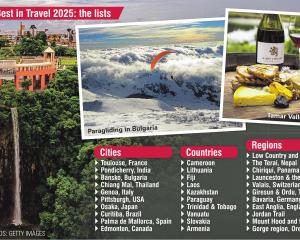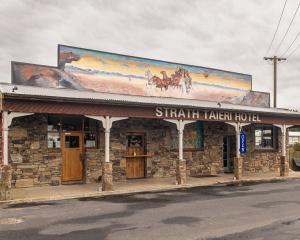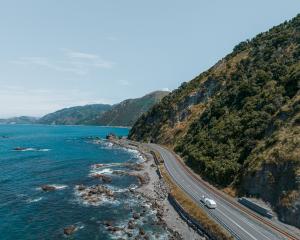Strolling through the streets of Sarajevo, the capital of Bosnia-Herzegovina, Anabright Hay finds much to admire.

A striking, stripped pseudo-Moorish building beside Sarajevo's Miljacka River has long featured on postcards and in guidebooks and is top of my list to explore.
How did such a building, inspired by the architecture of Mamluk Egypt and Moorish Spain, but not the Ottoman Balkans, come to be built in Bosnia-Herzegovina?
The Sarajevo City Hall opened in 1896 during the Austro-Hungarian occupation of Sarajevo. It was designed by Viennese-trained Croatian architects Aleksander Wittek and Ciril Ivekovic.
Strangely, the Pseudo-Moorish style was an Austro-Hungarian attempt to develop a Bosnian national style. It aimed to highlight Bosnia's Islamic heritage gained during more than 400 years of Ottoman rule. But Wittek was sent to Egypt and Spain for inspiration rather than looking closer to home. Later, a Bosnian national style of architecture, which drew more on local traditions, developed.
Badly damaged during the Siege of Sarajevo in 1992 the City Hall is now fully restored and reflects Sarajevo's fascinating and tumultuous history.
The city did not become the capital of an independent state until the 1990s and its architecture was largely instigated by outsiders. Their aims included not only nation building in Bosnia, but pursuing Ottoman, Austro-Hungarian and Yugoslav agendas.
Despite the trauma and destruction of the recent past much of this diverse legacy remains today. Animated groups of tourists are testament to Sarajevo's pulling power as a treasure trove of Ottoman, Austro-Hungarian and Bosnian national architecture.
Gleaming in the sun on a crisp May morning the city hall looks as fresh as the image on my 100-year old postcard. I can't wait to see inside and for five Bosnian marks I can.

Light floods in through its multicoloured windows highlighting the meticulously applied decorative paintwork high above the horseshoe arches in its round atrium and stairwell. I am alone except for a couple of official-looking men in suits whose voices are amplified in the vast splendour of the interior. An exhibition of architectural plans and photos displayed in the basement is riveting. It depicts the recent near total destruction of the interior of the building and literary contents and its recent restoration.
The Sarajevo City Hall has played many roles during its existence. It once housed the National and University Library of Bosnia and Herzegovina. In 1910, it became the home of the new Bosnian Assembly and Archduke Franz Ferdinand visited there before being assassinated nearby in June 1914. The assignation triggered the start of World War 1.
Keen to recapture the view on my postcard I cross a bridge opposite the city hall and stand on the riverbank. But a charming wooden Balkan village style cafe is slightly in the way. Figuring it is time for lunch anyway, and that I can get a good photo from the cafe balcony, I go in and sit down. Some decidedly Kiwi accents from the next table catch my attention. All roads lead to Sarajevo it seems and the young couple tell me they are from North Otago. We swap travel itinerary stories and tuck into our chicken-on-a-stick dish.

Suitably replenished, I head back across the river past the city hall and into the alleyways of the old Ottoman Turkish quarter, known as Bascarsija.
Its pedestrianised streets are full of cafes and wooden-shuttered souvenir shops. A shop selling sticky coloured Turkish delight in boxes decorated with pictures of the city hall has me glued to the window.
But after quickly calculating the difficulty of getting this confectionery, and its lovely box, back to New Zealand in one piece I reluctantly move on.
Despite the abundance of tour groups this area still has a genuine historic atmosphere. The central square, Sebilj leads past the coppersmiths' alley, Kazandziluk and on to medieval mosques and trading bazaars.
History is so ever-present and immediate in Sarajevo that part of the summer garden of my hotel, the Europe Hotel, was built on top of, and next to, the ruins of an Ottoman inn. The hotel was built in 1882 during the Austro-Hungarian occupation of Sarajevo. But the Taslihan, a stone inn, was erected between 1540 and 1543 by the Ottoman governor, Gazi Husrev Bey. Today both sit side by side in perfect harmony.

Sarajevo's harmonious pre-1990s past is also highlighted by the closeness of its 1889 neo-gothic Catholic cathedral, its 1872 Orthodox cathedral, built in Byzantine-Serb style, and a 1581 Jewish synagogue and museum. All these buildings are in the Ferhadija part of the city which was the Austro-Hungarian era's main 19th-century thoroughfare. I almost feel I could be in Vienna. It is an elegant area for an evening stroll and its many outdoor cafes are filled with people.
In the book Capital Cities in the Aftermath of Empires, Emily Gunzburger Makas says that despite the developments of socialist Yugoslavia and the recent destruction and renewal of the city, no period in Sarajevo's history witnessed such a dramatic transformation as the 40 years it served as the capital of the Austro-Hungarian province of Bosnia-Hercegovina.
I am eager to keep exploring before it gets dark and so venture further west into Marsala Tita, a long street with some exciting early 20th-century buildings.
At this time many social, cultural and religious societies built elaborate buildings to house their various activities. A Bosnian national style of architecture using more local decorative details emerged. My favourites are the ones that use allegorical figures in national dress. These figures are often in niches high above sight lines and difficult to photograph while dodging passing traffic.
But the real show-stopper statues right at street level are two huge lantern holders outside the National Bank of Bosnia Herzegovina at 25 Marsala Tita. These mysteriously androgynous figures guard the entrance to this strikingly beautiful modernist building designed in the 1920s by Milan Zlokovic. Zlokovic was a pioneer of the Serbian modern movement and designed many modernist buildings in Belgrade.
Sadly, the bank is closed so I cannot explore its interior.
But there is no shortage of museums in Sarajevo for those wanting to delve deeper into the many chapters of its history. One could almost drown under the weight of its triumphs and tragedies. But Sarajevo today wears it well and seems keen to celebrate much of its past. I am only too pleased to partake of a tiny slice of it.












